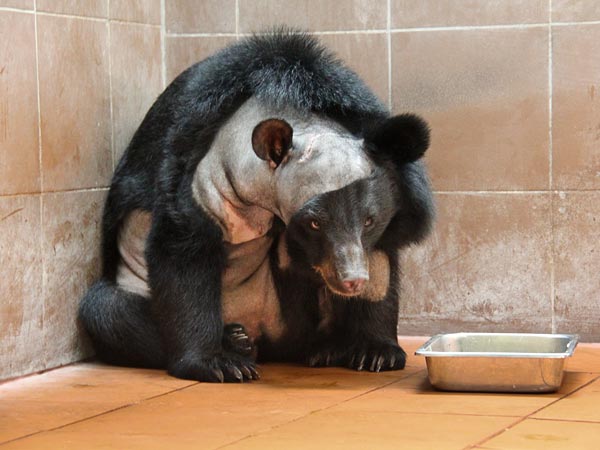First Brain Surgery Performed on Bear
In the mountains of northern Laos, a three-year-old Asiatic black bear has become a medical pioneer: the world's first bear to undergo brain surgery.
The bear, named Champa, has lived most of her life at a sanctuary run by Free the Bears, an Australian nonprofit group. About 20 miles (32 kilometers) south of the city of Luang Prabang, the sanctuary protects bears that Lao officials have rescued from wildlife traffickers. The Asiatic black bear, or moon bear, whose bile is considered a valuable ingredient in traditional Chinese and Korean medicine, is listed as vulnerable on the IUCN Red List of Threatened Species.
Rescued as a cub, Champa stood out from the start: She had a protruding forehead and had trouble socializing with the other bears at the sanctuary. Over time, her growth slowed, her behavior became more erratic, and her vision faded.
Sanctuary staff and veterinarians suspected hydrocephalus, or "water on the brain," a disease that strikes humans as well as animals. It's most commonly caused by the blockage or overproduction of cerebrospinal fluid in the brain's cavities.
Champa, an Asiatic black bear, recovering from brain surgery. She is the first bear to undergo such an operation.
In most Western countries, a wild animal with hydrocephalus would likely be euthanized. "Having hydrocephalus is like having an absolutely mind-blowing, constant migraine," said veterinarian Romain Pizzi. But because of the strong Buddhist tradition in Laos and the technicalities of its wildlife protection laws, euthanasia was not an option.
So Free the Bears called on Pizzi, a South African veterinary surgeon who works in Scotland at the Edinburgh Zoo and also at a national wildlife rescue center. Pizzi uses a technique called "keyhole," or laparoscopic surgery, in which surgery is performed through a small incision and with the help of a camera.
He has operated not only on bears but also on seals, reindeer, jaguars, and other species. No one had ever done brain surgery on a bear, though, and the risks were significant—but, Pizzi and Free the Bears decided, preferable to the agonizing death Champa would suffer if untreated.
Through a Keyhole, Gently
To prepare for the operation, Pizzi consulted with pediatric surgeons and studied Asiatic black bear skulls, a replica of a bear brain, and the brains of a hydrocephalic otter and fox. He packed equipment to carry from his home in Edinburgh to Laos, knowing that he would be operating under hot, humid conditions and with unreliable electricity. Since there was no MRI machine at the sanctuary (or anywhere in Laos), he would not be able to confirm the diagnosis of hydrocephalus until surgery began.
The six-hour procedure began on the morning of February 25. Pizzi drilled a small hole behind one of the sedated bear's ears, using an ultrasound probe to confirm that Champa was in fact hydrocephalic. Pizzi then inserted a thin tube through the hole into the brain and, guided by the camera, threaded the tube under her skin to her abdomen. The tube, which will remain in place indefinitely, is designed to drain excess cerebrospinal fluid into the abdominal cavity, where it can be easily absorbed into the body.
While the procedure went reasonably smoothly, Pizzi did have to improvise: At one point, a medical pump short-circuited in the high humidity. Pizzi resorted to a mattress pump instead to keep Champa's abdomen inflated.
The operation was completed by 4 p.m., and veterinarians kept watch on Champa through the night. By 8 a.m., says Free the Bears chief executive Matt Hunt, Champa was awake and "looking like a very different bear." Before the operation, her swollen head had weighed down her neck, but now she could raise her head to look directly at sanctuary staff. "There was a lot more recognition," said Hunt. "We can't know if her vision is fully recovered, but everyone certainly believes her vision has improved."
While Pizzi doesn't expect to perform neurosurgery on a bear again anytime soon, he has already performed several gallbladder surgeries on bears rescued from Asian bile farms. Because of the ongoing demand for bear bile as a traditional medicine in China, living bears are "tapped" for their bile, with dirty catheters and needles often leaving the animals with infected gallbladders that must be removed.
Keyhole surgery is common in human medicine, and Pizzi and other wildlife specialists believe that animals also benefit from its shorter recovery time and reduced risk of infection. Animals who undergo keyhole surgery are far less likely to tear open their own incisions through scratching or grooming, for example, and are able to return to normal activities much more quickly. However, because keyhole surgery is more expensive than traditional surgery, and requires specialized training and ongoing practice, Pizzi is one of only a handful of veterinarians who use the technique in wildlife surgery.
No matter the species or the organs involved, Pizzi says that every procedure gives him a chance to test his techniques, helping him lower the risks for future patients. That's especially important for animals from extremely rare species, for which the loss of one individual can make the difference between survival and extinction. "We are all learning, and when we need these skills we will really need them," he said. "There are some very endangered animals out there that we won't get a chance to learn on."
Her Headaches Are Gone
Six weeks after the operation, Champa is markedly more active and more social with other bears, and she is gaining weight. She will always have some brain damage, since the accumulated fluid does cause permanent harm. And she will remain in captivity. But her relief is obvious.
"Operating on one bear won't save bears from extinction, and making life better for one bear won't change the world," said Pizzi. "But the world of that one bear is changed forever."
Michelle Nijhuis
for National Geographic News
Published April 11, 2013












